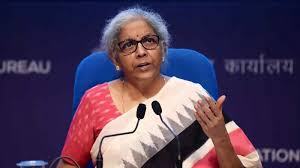Drug peddlers targeting schools & colleges; narcotics now a bigger threat than gold smuggling, says Sitharaman

Union Finance Minister Nirmala Sitharaman recently issued a stark warning about a troubling rise in drug trafficking targeting schools and colleges in India. She said that narcotics have now become a more dangerous threat than gold smuggling, which was long seen as one of the biggest illicit trades in the country.
The Growing Menace of Narcotics in Educational Institutions
Drug abuse among young people is a serious concern worldwide, and India faces this challenge too. Sitharaman revealed a worrying trend: drug peddlers are increasingly focusing on schools and colleges. These traffickers prey on vulnerable students. Young people at this age are impressionable and easily influenced.
Narcotics in educational settings create more than just individual problems. They signal a larger systemic issue that requires urgent attention. Schools and colleges should be safe places for learning and growth. Instead, these places are increasingly being invaded by illicit drug networks. These networks thrive by exploiting the curiosity, peer pressure, and stress that students face.
Narcotics vs. Gold Smuggling: A Shift in the Threat Landscape
Gold smuggling has long been a major issue for Indian authorities. It impacts the economy and poses security challenges at the borders. However, the situation is shifting. Narcotics trafficking is growing fast and poses a more immediate threat.
Sitharaman noted that drug networks have become smarter and more organized. Smugglers now use new routes, advanced technology, and clever methods to move narcotics across borders. This makes it difficult for law enforcement to detect and stop these activities. Unlike gold smuggling, narcotics cause direct harm to public health. They fuel addiction, crime, and social decay.
Why Are Drug Peddlers Targeting Schools and Colleges?
There are several reasons why narcotics are spreading in educational institutions:
- Vulnerability of Youth: Teenagers and young adults often experiment. They can be more susceptible to trying drugs, especially if offered by peers.
- Peer Pressure and Mental Health: Students face academic pressure and anxiety. Many want to fit in with their friends, making them easy targets for dealers.
- Easy Access: Drug traffickers use social media, peer networks, and even dark web markets. These channels help them reach students discreetly.
- Lack of Awareness: Many students and parents don’t recognize the early signs of drug abuse. This delays intervention and makes the problem worse.
Government’s Efforts to Fight the Drug Menace
The government is stepping up its efforts to combat drug trafficking with several measures:
- Stronger Surveillance and Border Checks: Authorities use advanced technology to monitor borders closely. They aim to catch drug shipments before they enter the country.
- Partnerships with Schools and Colleges: Educational institutions are encouraged to run awareness programs about the dangers of drugs. Teachers and counselors receive training to spot early signs of abuse.
- Tougher Legal Actions: The government pushes for stricter laws and faster trials for drug traffickers. This aims to deter others from trafficking drugs.
- Community Involvement: Local authorities and NGOs work together to create drug-free zones. They also support rehabilitation efforts for addicts.
- Digital Reporting Tools: Apps and platforms are being developed to allow anonymous reporting of drug-related activities near schools and colleges.
Impact on Society and the Economy
The drug crisis affects more than just individuals. It impacts society and the economy deeply:
- Public Health: Drug addiction leads to mental health problems and makes users vulnerable to diseases.
- Crime Rates: Narcotics trade fuels violence, theft, and other crimes.
- Economic Costs: Drug abuse lowers productivity and raises healthcare expenses. Law enforcement also spends more resources fighting drug crimes.
- Social Breakdown: Families suffer from addiction-related issues. Communities become unstable as drug use spreads.
Why Narcotics Pose a Greater Danger Than Gold Smuggling
Gold smuggling mainly affects the economy and government revenues. Narcotics, on the other hand, threaten the nation’s youth and social fabric. Sitharaman’s comparison stresses the need to prioritize narcotics control in India’s policies.
Gold smuggling threatens financial systems and trade security. Narcotics cause addiction and crime that break down society from within. The effects of drug abuse are often hidden until they reach a critical point. This makes prevention and early action vital.
The Role of Parents, Educators, and Society
Fighting drug abuse requires collective effort:
- Parents must stay alert and talk openly with their children about drug dangers.
- Educators should include drug awareness in teaching. They must create a safe environment where students can seek help.
- Communities need to support rehabilitation and avoid stigmatizing recovering addicts.
- Students can become peer educators and stand against drug use.
Moving Toward a Drug-Free Future
The rise of drug peddlers in schools and colleges is a grave threat. Sitharaman’s warning highlights the urgent need for vigilance and action. Protecting young people means stronger enforcement, education, family involvement, and community support.
Together, these efforts can reduce drug abuse and keep India’s youth safe. The fight against narcotics is complex but essential. The nation’s progress depends on the health and future of its younger generation.






